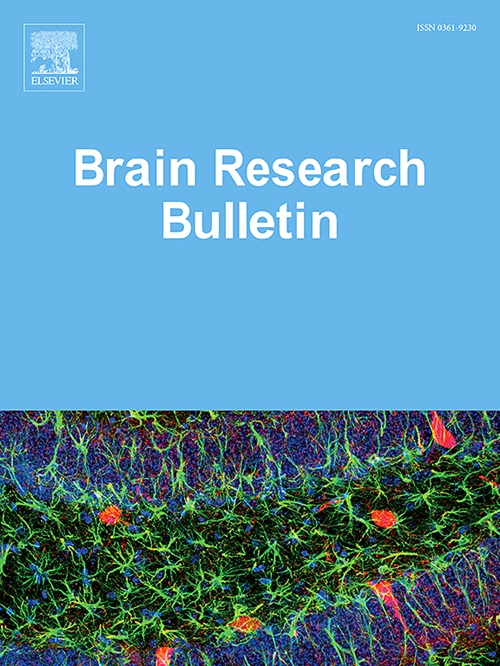Edaravone Dexborneol provides neuroprotective effect by inhibiting neurotoxic activation of astrocytes through inhibiting NF-κB signaling in cortical ischemia
IF 3.5
3区 医学
Q2 NEUROSCIENCES
引用次数: 0
Abstract
Edaravone Dexborneol (EDB), comprised of edaravone and (+)- bornel, has been demonstrated to have synergistic effects of antioxidant and anti-inflammatory, which makes it to be applied for stroke as a protectant. However, the underlying mechanism of neuroprotection of EDB has not been fully elucidated. Increasing evidence has shown that neurotoxic A1 astrocytes were closely related to neuronal death after cerebral ischemia. However, whether EDB could provide neuroprotection by modulating the activation of astrocytes has not yet been elucidated. The present study aimed to explore whether EDB afforded neuroprotection by modulating A1 polarization of astrocytes and the down-stream signaling after cerebral ischemia. We first validated the neuroprotective effects of EDB in mice suffering focal cerebral ischemia via evaluating behavioral test, infarct volumes and neuronal survival. As for the down-stream signaling, our data further showed that EDB alleviated neuronal death by suppressing activation of neurotoxic A1 astrocytes via inhibition of NF-κB signaling pathway in vitro. Additionally, administration of EDB reduced the number of A1 reactive astrocytes in mice of focal cerebral ischemia. The above findings demonstrated that EDB provided neuroprotective effect by inhibiting neurotoxic activation of A1 astrocytes in animal model of cerebral ischemia, which indicated that EDB-mediated phenotypic regulation of astrocytes is a potential research direction to promote neurological recovery in central nervous system (CNS) diseases.
在大脑皮层缺血时,依达拉奉-右旋龙通过抑制 NF-κB 信号传导,抑制星形胶质细胞的神经毒性激活,从而发挥神经保护作用
依达拉奉-右旋波旁醇(EDB)由依达拉奉和(+)-波旁醇组成,已被证实具有抗氧化和抗炎的协同作用,因此可作为一种保护剂应用于中风。然而,EDB 保护神经的内在机制尚未完全阐明。越来越多的证据表明,神经毒性 A1 星形胶质细胞与脑缺血后神经元的死亡密切相关。然而,EDB 是否能通过调节星形胶质细胞的活化来提供神经保护尚未得到阐明。本研究旨在探讨 EDB 是否能通过调节脑缺血后星形胶质细胞的 A1 极化及下流信号转导来提供神经保护。我们首先在局灶性脑缺血小鼠中通过行为测试、梗死体积和神经元存活率的评估验证了EDB的神经保护作用。在下游信号传导方面,我们的数据进一步表明,EDB通过抑制体外NF-κB信号通路,抑制神经毒性A1星形胶质细胞的激活,从而缓解神经元死亡。此外,服用EDB还能减少局灶性脑缺血小鼠A1反应性星形胶质细胞的数量。上述研究结果表明,EDB可抑制A1星形胶质细胞的神经毒性激活,从而对脑缺血动物模型起到神经保护作用,这表明EDB介导的星形胶质细胞表型调节是促进中枢神经系统疾病神经功能恢复的一个潜在研究方向。
本文章由计算机程序翻译,如有差异,请以英文原文为准。
求助全文
约1分钟内获得全文
求助全文
来源期刊

Brain Research Bulletin
医学-神经科学
CiteScore
6.90
自引率
2.60%
发文量
253
审稿时长
67 days
期刊介绍:
The Brain Research Bulletin (BRB) aims to publish novel work that advances our knowledge of molecular and cellular mechanisms that underlie neural network properties associated with behavior, cognition and other brain functions during neurodevelopment and in the adult. Although clinical research is out of the Journal''s scope, the BRB also aims to publish translation research that provides insight into biological mechanisms and processes associated with neurodegeneration mechanisms, neurological diseases and neuropsychiatric disorders. The Journal is especially interested in research using novel methodologies, such as optogenetics, multielectrode array recordings and life imaging in wild-type and genetically-modified animal models, with the goal to advance our understanding of how neurons, glia and networks function in vivo.
 求助内容:
求助内容: 应助结果提醒方式:
应助结果提醒方式:


